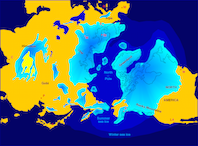22,000 BP
It is not sensible to discuss “the end of the last ice age” unless we can agree what ice ages are and how they happen. This is far from clear. To increase ice-cover on the Earth there has to be lots of water in the atmosphere that is dumped as snow in cold places. But an overall colder Earth evaporates less water into the atmosphere. “Ice ages” are not just about average temperature of the Earth.
What ‘ice-age’ actually means is that more of the Earth’s water was locked up in ice, causing lower sea levels, and some places on the Earth were covered in ice that are now free of ice. There are places on the Equator that were certainly covered by glaciers in times past - the evidence can be seen in the rocks. But at no time has the Earth been completely ice-covered. If it had been frozen all the way from the poles to the Equator we would see that in the fossil record as there would have been massive extinction of land animals. This also cannot have been caused by continental drift as the glaciers are too recent. There is something else going on in the creation and disappearance of ice cover.
At the last glacial maximum there was ice cover over most of Great Britain, Scandinavia, the North of Germany and the North West of Russia. Most of Siberia was clear of ice, despite all of Siberia being closer to the current North pole than Great Britain.
Over in the Americas the Laurentide ice sheet covered all of Canada and the North East of the USA.
If you use an atlas to draw round the areas of Northern hemisphere ice cover at the last glacial maximum, you will find that the ice-cover fits within a rough circle. This circle is of a similar size to the ice cover currently on Antarctica and surrounding seas. This is not very surprising. You would expect the North and South pole to be at similar temperatures and to accumulate ice down to similar lattitudes. There will be some variation as there is more sea in the Northern pole area than there is in the Southern pole area. Much greater thicknesses of ice can accumulate on land than it can on the sea.
The current ice-cover is a mystery. If ice cover was simply dependent on how far from the North or South pole the land is, Finland, Sweden, Norway and the North of Canada would be almost entirely covered by ice, as Greenland is. Though these areas get snow-cover in Winter, it is not thick enough to remain all Summer. Once the reflecting ice melts the sun is absorbed by the land much more readily, which then warms the air above it. The weather in Greenland remains much colder because the land is never exposed, the more reflective ice stops the sun’s heat being absorbed. It appears that the difference is that Greenland has built up a massive thickness of ice whereas the other areas North of 50 degrees have not.
And it is a mystery why the rough circle round the ice-cover we know to have been present 22,000 years ago is centred not at the current North pole, but somewhere over the Hudson Bay area of northern Canada.
The known extent of ice cover at the last glacial maximum rather suggests that 22,000 years ago the North pole was situated in Hudson Bay. And the huge depths of ice-cover on Greenland and most of Antarctica suggest that they might have been gaining ice-cover for far longer than those areas where ice-cover has melted since the last glacial maximum. Some earth-process that is not conventionally accepted must be at play here.
Read the story for more.



